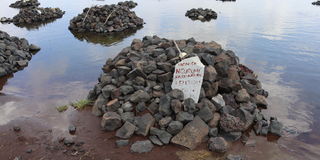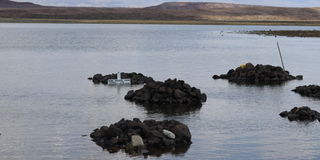Premium
No end in sight for nightmare caused by rising L. Turkana waters

Graves submerged by swelling Lake Turkana waters at Leyani village in Loiyangalani in Marsabit County on October 21, 2020.
A man tugs a boat to the shore of the greenish waters of Lake Turkana near Loiyangalani town in Marsabit County.
He undresses and dives into the waters.
Fishermen in this part of the lake use spears or harpoons, fishing rods and nets made from doum palm fibre to catch fish in this desert lake.
But, while fishing is one of the economic mainstays of the El Molo, one of Kenya’s tiniest tribes, it is the continued rising water levels in Lake Turkana that are giving locals a nightmare.
Houses and business premises in the low lying areas have been adversely affected.
In some areas even infrastructure has been submerged and others made completely inaccessible.
Already, more than 70 graves in Leyani Village have been submerged by water. Mr Paul Lekapana from the El Molo community and who is an environmental expert warned that the rising water levels were likely to end up being catastrophic if a timely intervention is not done.
“This is a time bomb our people are sitting on here. Even graves are now lying in water and the dead are not left to rest in peace,’’Mr Lekapan said.
He was saddened that Komote Village, which was initially connected to El Molo Bay Primary School and a local dispensary, was already cut off and residents had to use motorboats to cross the three kilometer stretch.
He expressed concern over the fate of El Molo Bay Primary School whose three toilets had been submerged, thus exposing the learners to massive hygiene risks such as a cholera outbreak.

In some areas, even infrastructure has been submerged and others made completely inaccessible due to increased water levels.
El Molo Bay Primary School headteacher Richard Lokok also expressed his fears over the danger posed by the rising water levels.
He was scared that the entire school compound might be submerged, thus decimating the only school for the El Molo community.
Mirikiye Lowa, 46, is one of the Layeni area residents whose huts were submerged by the rising waters.
He was forced to move and erect another hut 20 metres away and is crossing his fingers that the water levels will not continue rising.
Loiyangalani MCA Stephen Nakeno echoed Lowa’s sentiments that their livelihoods were adversely affected, leaving them on the verge of starvation.
“The livelihoods of our people have been devastatingly disrupted and even young children are now forced to join their family members in looking for means of survival,’’ Mr Nakeno lamented.
Mr Nakeno was unhappy that children aged between 8 and 12 years were forced to fish for mudfish and sell it to ensure they had food on the table.
He said that the only fish cold room on the Loiyangalani shorelines was already submerged by water and was no longer in use.
Also the multi-million-shilling fish plant that was established in the area with the help of the European Union and the county government could be submerged.
He appealed to well-wishers to intervene before the situation gets worse.
The fish plant, which was undertaken through EU grants worth Sh250 million, and which was nearly 90 percent complete, faced the risk of being submerged like other infrastructure since water was lying just 50 metres away.
Lake Turkana is 300km long and 50km wide, which also makes it the largest lake in Kenya. It is also the world's largest permanent desert lake.
Alarm has been sounded at the rising water levels in Rift Valley lakes, which have swallowed homes, utilities and displaced animals in parks.
The rising waters are worrying residents and scientists, who seem not to have sufficient explanation as rains have not fallen in huge volumes over the past few months.
Lakes Nakuru, Naivasha, Baringo, Turkana and Bogoria have expanded to levels not seen in 75 years, with the Water Resources Authority (WRA) revealing that the phenomenon has affected the quality of water.
WRA attributes the rising water levels to tectonic activities and the effects of climate change on rainfall patterns. WRA says water levels in all the five lakes in the Rift Valley have risen to the highest recorded levels in recent years.





